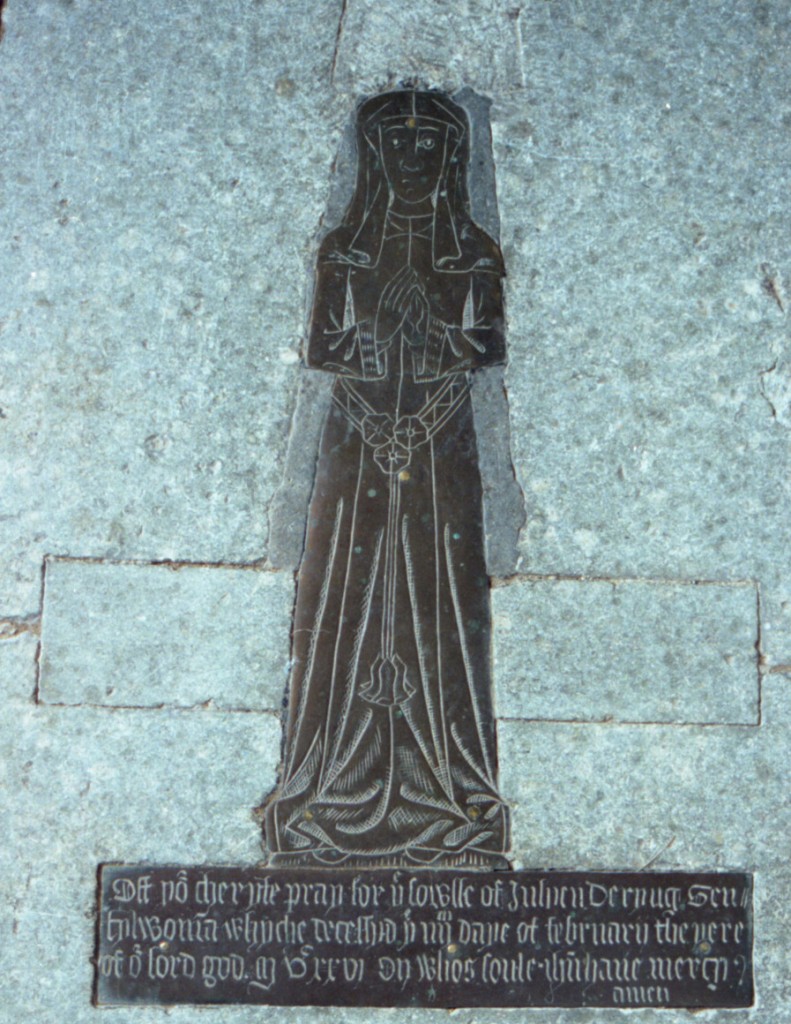Portfolio of Brasses
Each month we feature an article about a brass of particular interest.
If you would like to submit an article for this feature please contact:
-
German Pole and his widow Margaret
County: Derbyshire
Date: 1592
November 2025
The incised alabaster slab of German Poole or Pole (d.1592) and his second wife Margaret is now set in the north wall of the chancel. It was originally on the floor. In 1861 it was moved to a new position on the floor and covered by a wooden board. This proved an obstacle, so it was moved again to its present position above the tomb chest of John Clay. He had married Margaret Pole after her husband’s death. She is depicted again on the incised slab on the top of the chest.
German Poole had no children by either wife,...
read more
-
Margaret Tresham
County: Northamptonshire
Date: 1604
October 2025
The church of St Faith in Newton by Geddington (or Newton-in-the-Willows) was disused and derelict in the early 1970s. It is now a private house. All its church furniture and fittings have long since been removed. The brasses and incised slab listed in it were transferred to Geddington in or before 1974, with one exception. The inscription to Dorothy Tresham, d.1653 (M.S.III in Mill Stephenson's List of Monumental Brasses in the British Isles, 1926) is believed to have been stolen while the church was derelict and never recovered.
One of the brasses from Newton, that commemorating John Mulsho and his...
read more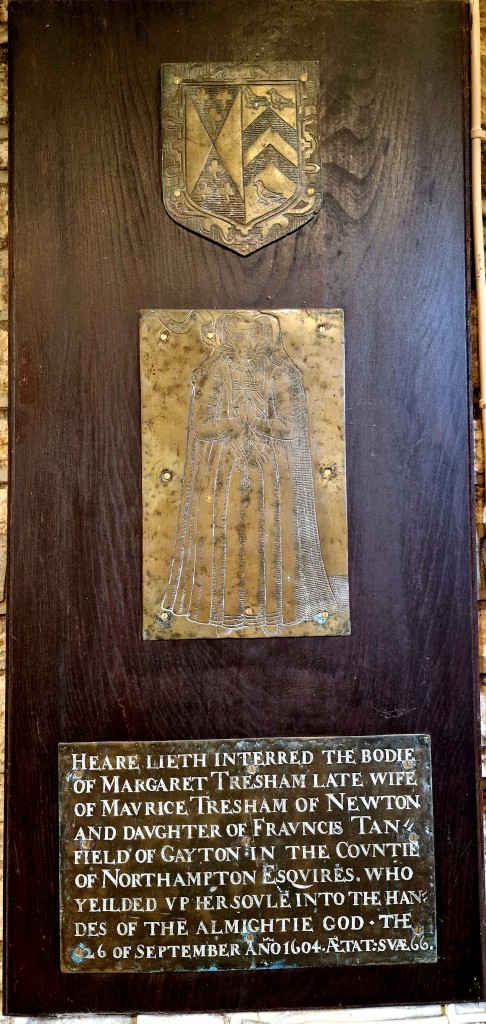
-
Richard Wenman
County: Oxfordshire
Date: c.1510
September 2025
Richard Wenman's brass effigy lies on the top slab of a Purbeck marble tomb chest now placed towards the west end of St Mary’s church in Witney. He is shown between the effigies of two wives, each with figures of daughters below. Some components of the brass are missing: the marginal inscription; one of the four shields on the top slab; three sons below Richard’s effigy; and shields in the panels on the sides of the tomb chest. Otherwise the brass is complete, with scrolls above the three main figures and a Trinity above Richard’s head.
Richard is variously described...
read more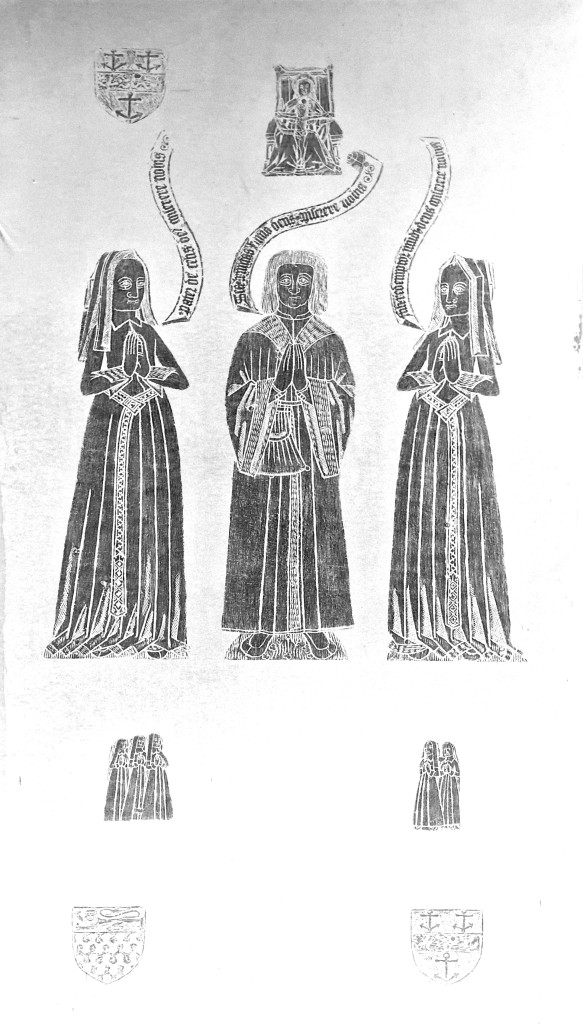
-
John Lowe
County: Sussex
Date: 1426
July 2025
There is still much to be discovered about the men who made monumental brasses. By the late fifteenth century they had their own London company, the Marblers, but quite how individual marblers worked is unclear. By 1585, when their company was absorbed into the larger Masons' Company, their number was seemingly small, but still outnumbered the styles into which brasses at the time can be divided.
The divorce of figure and inscription styles from each other during the sixteenth century suggests increased specialisation, and also a fair degree of literacy of those cutting inscriptions. There may have been further division between...
read more
-
John Berney
County: Norfolk
Date: 1536
June 2025
A stylish and well-engraved plate showing a helmet with a crest and mantling is all that remains of a brass in the church of St John the Baptist, Reedham, Norfolk. There are indents of three missing shields (one of which survived as late as 1938). The slab must have been cut down, for we know from old descriptions that there were formerly scrolls and an inscription as well.
Suffling's English Church Brasses (1910), a general book but with a marked East Anglian slant, illustrates this Reedham brass under 'heraldry' with the comment, ‘it may have belonged to the Berneys’. The same crest, A...
read more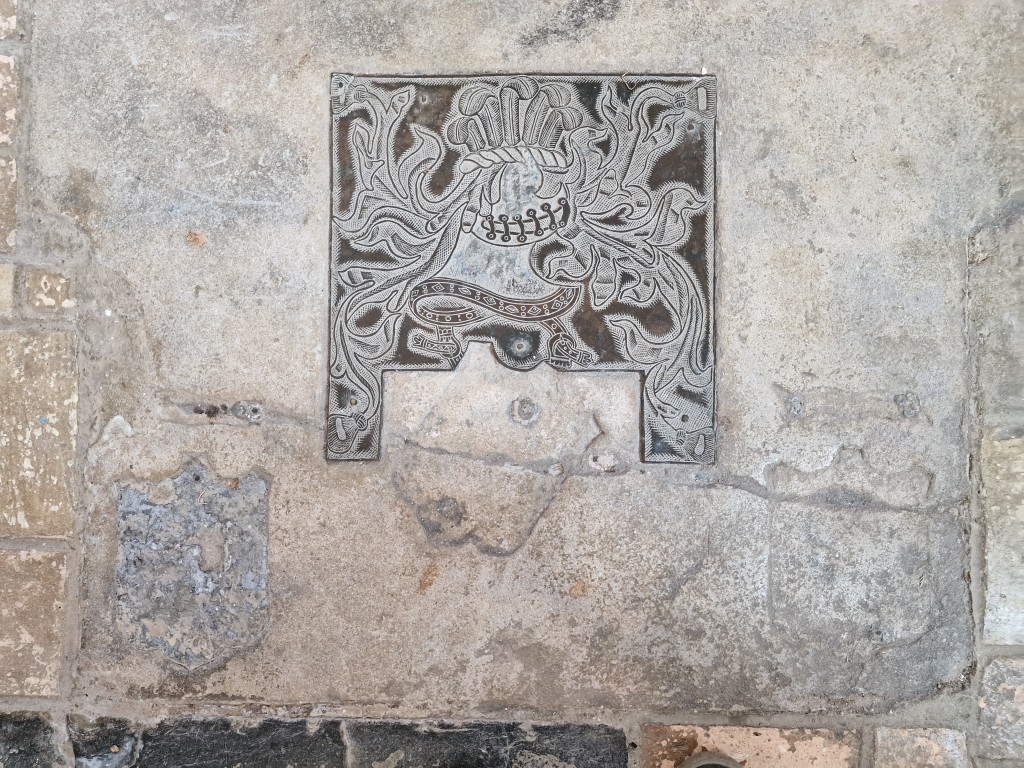
-
John, William and Richard Sherman
County: Devon
Date: 1638
May 2025
The town of Ottery St Mary lies on the River Otter, a few miles from the coast, but the brass plates that make up this memorial to a father, son and grandson of the Sherman family were probably laid locally. Their effigies are in the style of Edward Marshall, the London tomb sculptor and engraver, but the usual black Belgian marble used at the time for inlaying brasses has been replaced by limestone. Whether the plates were sent from London to Devon by road or by sea is open to question. If by road, it echoes what was done...
read more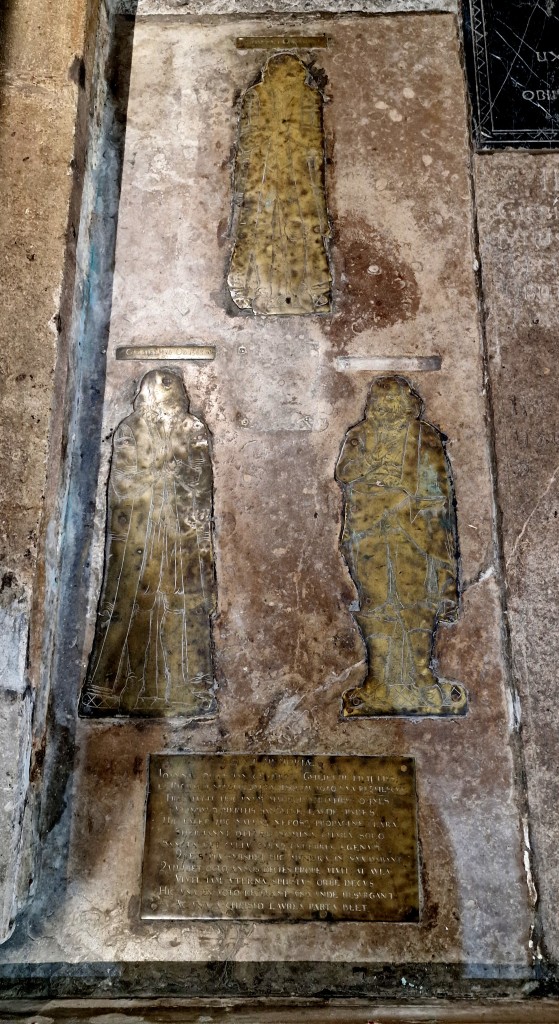
-
Hugh Starkey
County: Cheshire
Date: c.1526
April 2025
Given the paucity of brasses which survive in the county of Cheshire, the very fine memorial commemorating Hugh Starkey esquire (the spelling of the surname varies) in St. Chad’s church, Over, (near Winsford) is not as well-known as perhaps it should be.
My initial interest in this particular brass was piqued because an article on the Internet states, albeit thankfully mistakenly, that it was stolen some years ago which, fortunately, is not the case. Nonetheless, for those intending to visit the church...
read more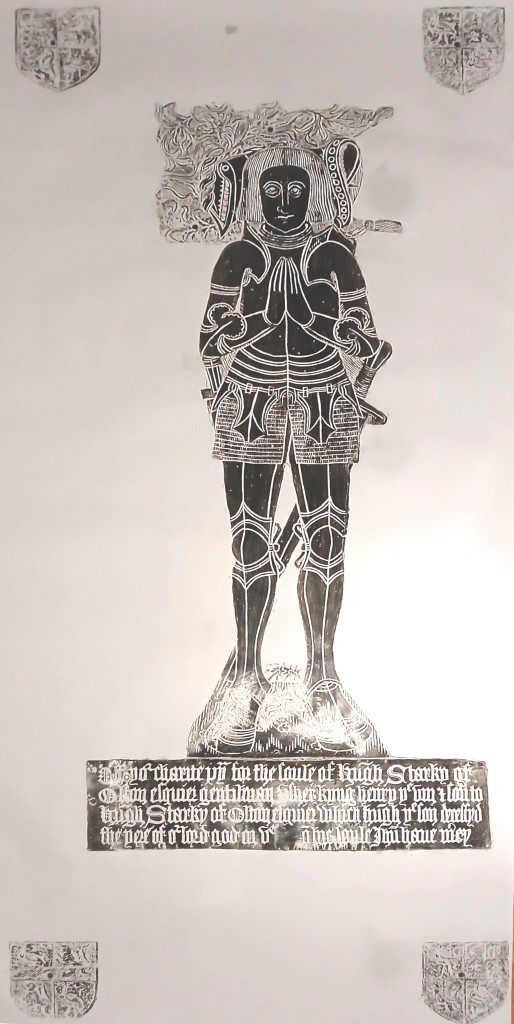
-
Anne Odyngsale
County: Warwickshire
Date: 1523
March 2025
The inscription on her brass tells us that Anne, daughter of Richard Verney, married Edward Odyngsale of Long Itchington. She died in 1523. The Verneys lived at Compton Verney. Long Itchington is less than ten miles away in the same county.
The style of the inscription and of Anne’s figure shows that the brass was made in Coventry. It belongs to the Coventry 3 style. The capital letters E in her inscription differ from those in later inscriptions in the same style, which use a Roman capital E.
Edward Odyngsale died in 1522, so Anne is shown as a widow. Otherwise Anne...
read more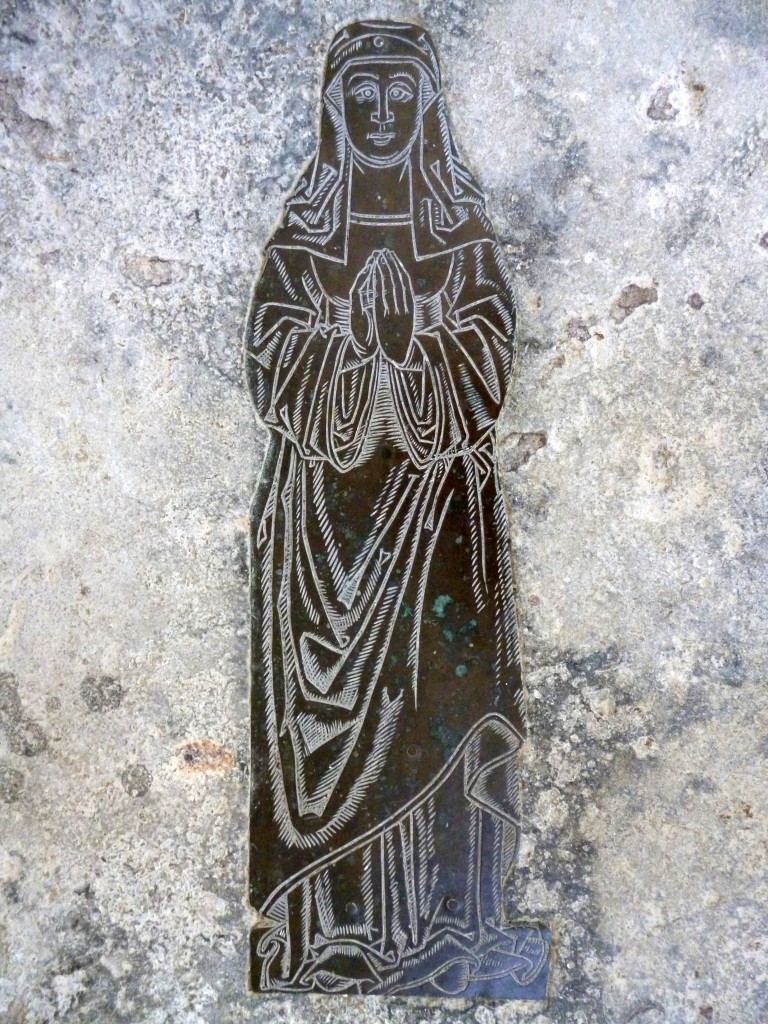
-
William & Ann Wright
County: Yorkshire
Date: 1621
February 2025
The sculptor Francis Grigs is perhaps best known for his signed 1638 sculpted monument in the church at Framlingham, Suffolk, commemorating Sir Robert Hitcham, d.1636. This comprises a black marble slab on the shoulders of four figures (angels in this case). The precedents for this design go back to the 1520 monument of Count Engelbert of Nassau at Breda in the Netherlands. The same inspiration lies behind the monuments of Sir Francis Vere, d.1609, in Westminster Abbey, and Robert Cecil, earl of Salisbury, d.1612, at Hatfield, Hertfordshire.
For monumental brass enthusiasts, the brasses with his signature for Richard and Jane Cressett,...
read more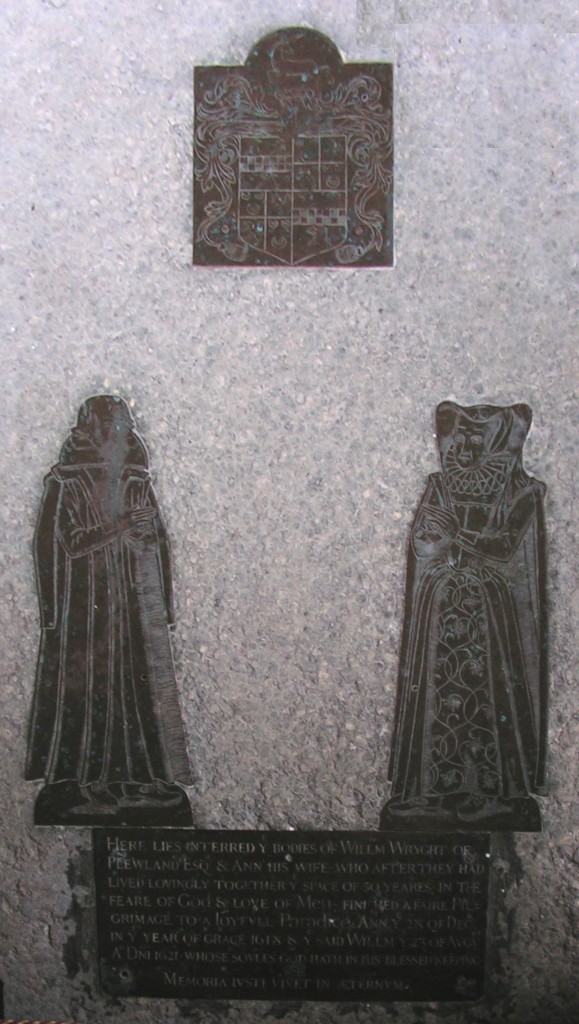
-
Thomas Hawtrey
County: Buckinghamshire
Date: 1544
January 2025
Thomas Hawtrey was the last of a succession of men of the same name to live at Chequers in the parish of Ellesborough, Buckinghamshire. He was aged thirty or more at the Inquisition post mortem following his father’s death in 1522, an age close to that of Henry VIII. Perhaps it was this that kept him from suffering any serious consequences when he was one of a dozen men to rob the nest of a goshawk in a wood belonging to the king in Ellesborough in 1530, taking a number of fledglings. He and his accomplices were summoned to...
read more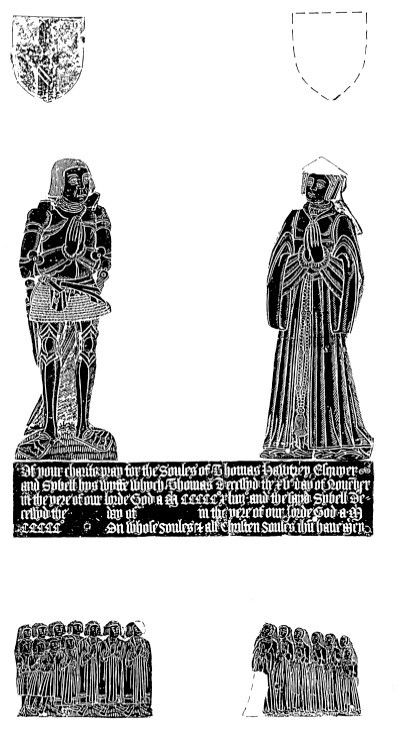
-
Henry Fazakyrley
County: Buckinghamshire
Date: 1531
December 2024
The surname Fazakerley derives from a place now part of Liverpool, and the early history of the family relates to the Liverpool area, especially Walton, where a William Fazakerley was buried in 1600. However one member of the family was buried in 1531 in the church of St Mary at Drayton Beauchamp, Buckinghamshire and was commemorated by a brass.
Henry Fazakyrley was not a rector of the church. Lipscomb’s 1847 county history records Humphrey Dayrell being...
read more
-
Susan Parker
County: Suffolk
Date: 1604
November 2024
Before the Reformation, inscriptions on brasses occasionally featured decoration, either at the ends of lines as a filler or, on marginal inscriptions, between words, often in the form of animals or rebuses. From the late 1530s onwards the dissolution of the monasteries meant that huge quantities of brass plate became available both to the marblers producing monumental brasses and to the founders for melting down alongside candlesticks, brass lecterns and other plate. This led to a decrease in metal prices. The laws against exporting particular metals brought in by Henry VIII and strengthened under Edward VI may not have...
read more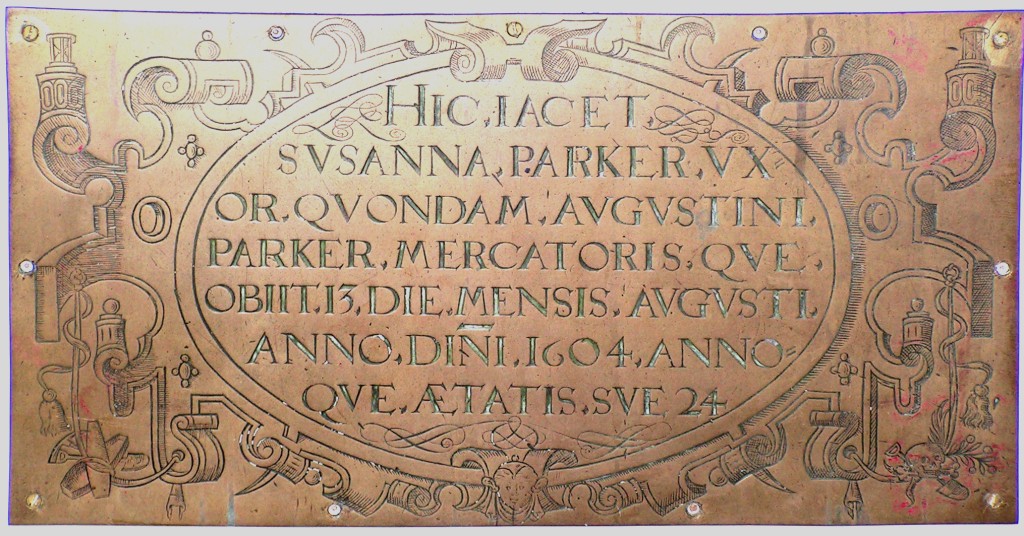
-
Nicholas Purefey
County: Leicestershire
Date: 1545
October 2024
F A Greenhill's The Incised Slabs of Leicestershire and Rutland (1958) includes, as well as a gazetteer of the slabs of these two counties, a 'Brief Manual of Incised Slabs’ and an appendix listing slabs with incised effigies in England, Scotland and Wales, arranged by county. Greenhill recognised that the bulk of the earlier slabs were likely to have originated at or close to Chellaston in Derbyshire, while the later ones were the work of Burton-upon-Trent engravers. The latter were much more likely to have acquired their alabaster from Staffordshire quarries, such as that at Fauld.
Greenhill attempted to group slabs with...
read more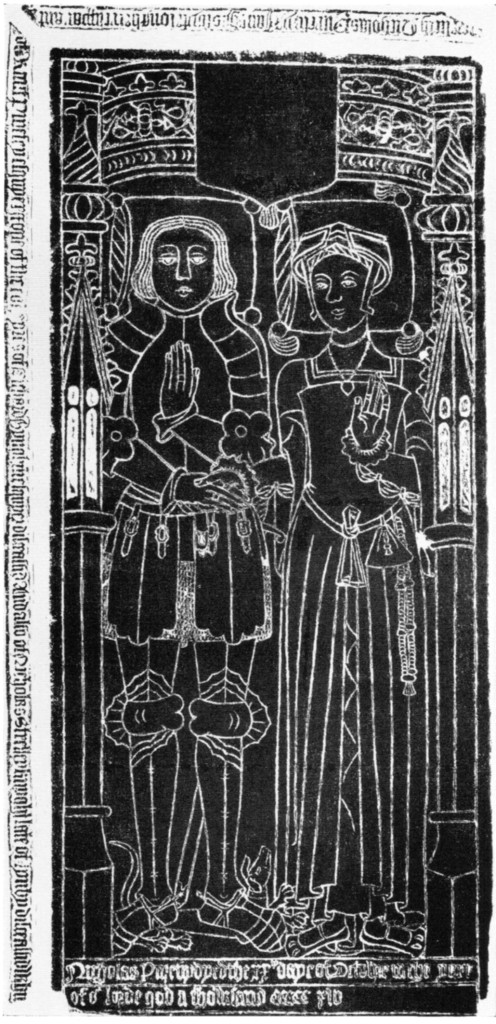
-
Alice Joyner
County: Suffolk
Date: 1558
September 2024
T M Felgate was the author of three books on Suffolk brasses. Ladies on Suffolk Brasses (1989) covered forty effigial brasses, illustrating only the female effigies, and ignoring husbands and children if present. Not all of his research has stood the test of time, but that on the lady at Ellough appears accurate. He gives the wording of the missing inscription:
Here lyeth buryed Alyce Joyner sometyme wife of Paul Sydnor esquier and after of John Berney of Reedham Esq. w’h dyed the first day of May in the yeere of our Lorde God 1558 on whose soule Jesu have...
read more
-
Elizabeth Beresford
County: Lincolnshire
Date: 1624
August 2024
Peter le Neve, Norroy King of Arms, collected an enormous amount of antiquarian information during his lifetime. However his methods of organising this material left a lot to be desired. He possessed two particularly valuable anonymous manuscripts, The Chorography of Norfolk and The Chorography of Suffolk, both compiled in the very early years of the seventeenth century. Le Neve cut much of the Suffolk volume into small strips, arranged into his desired order, and had his amanuensis copy the content of these strips. He died before he could do the same to the Norfolk volume, which survived to be...
read more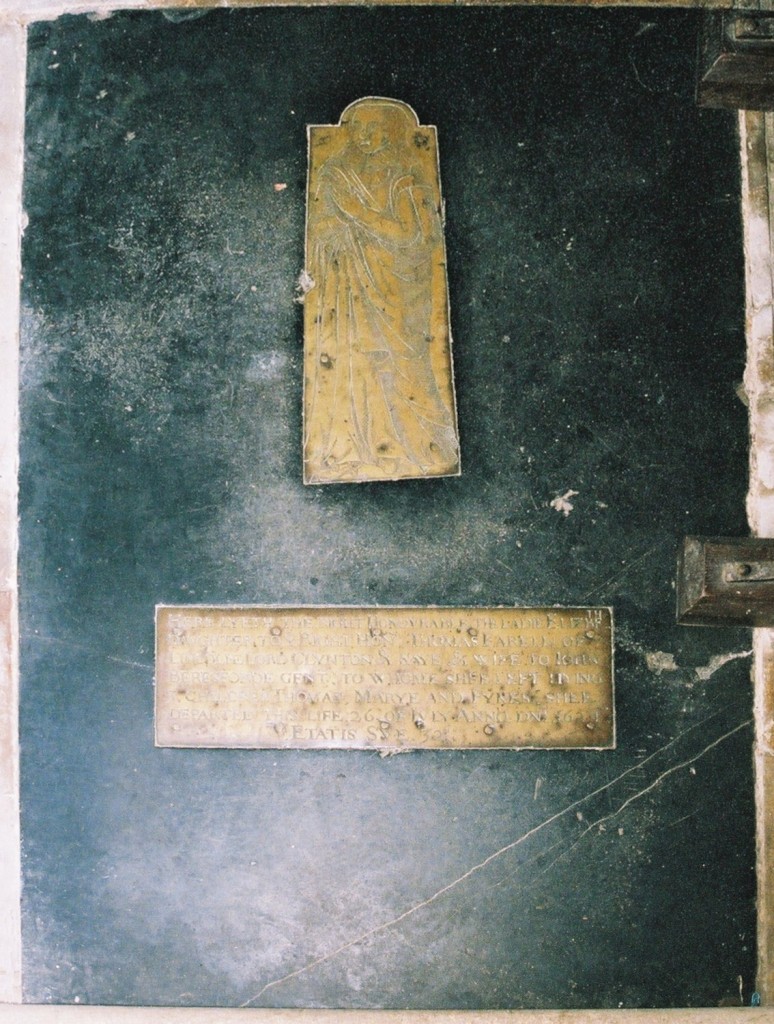
-
Robert Hacombleyn
County: Cambridgeshire
Date: 1528
July 2024
Few visitors to King’s College chapel notice Robert Hacombleyn’s brass, which for many years has been missing the foot inscription that would have contained his name. The brass is on the floor of Hacombleyn’s chantry chapel on the south side of the college chapel.
His brass was produced locally by a Cambridge marbler and now consists of a figure in a furred almuce; a scroll issuing from his hands with the words Vulnera Christe tua michi dulcis sint medicina ('May your wounds, O Christ, be sweet medicine to me'); a marginal inscription with a text from the Office of the Dead,...
read more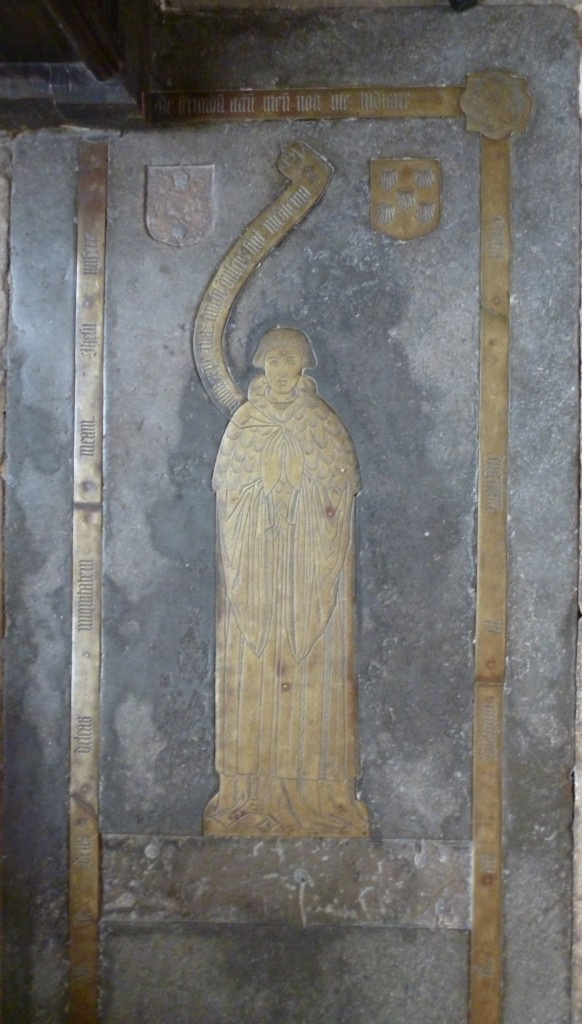
-
Simon and Merrial Coates
County: Oxfordshire
Date: 1644
June 2024
From around the 1620s to the middle of the seventeenth century a number of memorial slabs substituted white marble inlays for brass, set in in black marble. Although quite a number of white marble inscriptions survive, there are few white marble figures. The prime example of the latter is the slab for Elizabeth Havers, died February 1633/4, at Stockerston, Leicestershire. Here the rectangular inlay with her figure takes up most of the slab and has a further white marble foot inscription plus two armorial shields. There are further inscriptions on the black marble to either side of the figure.
read more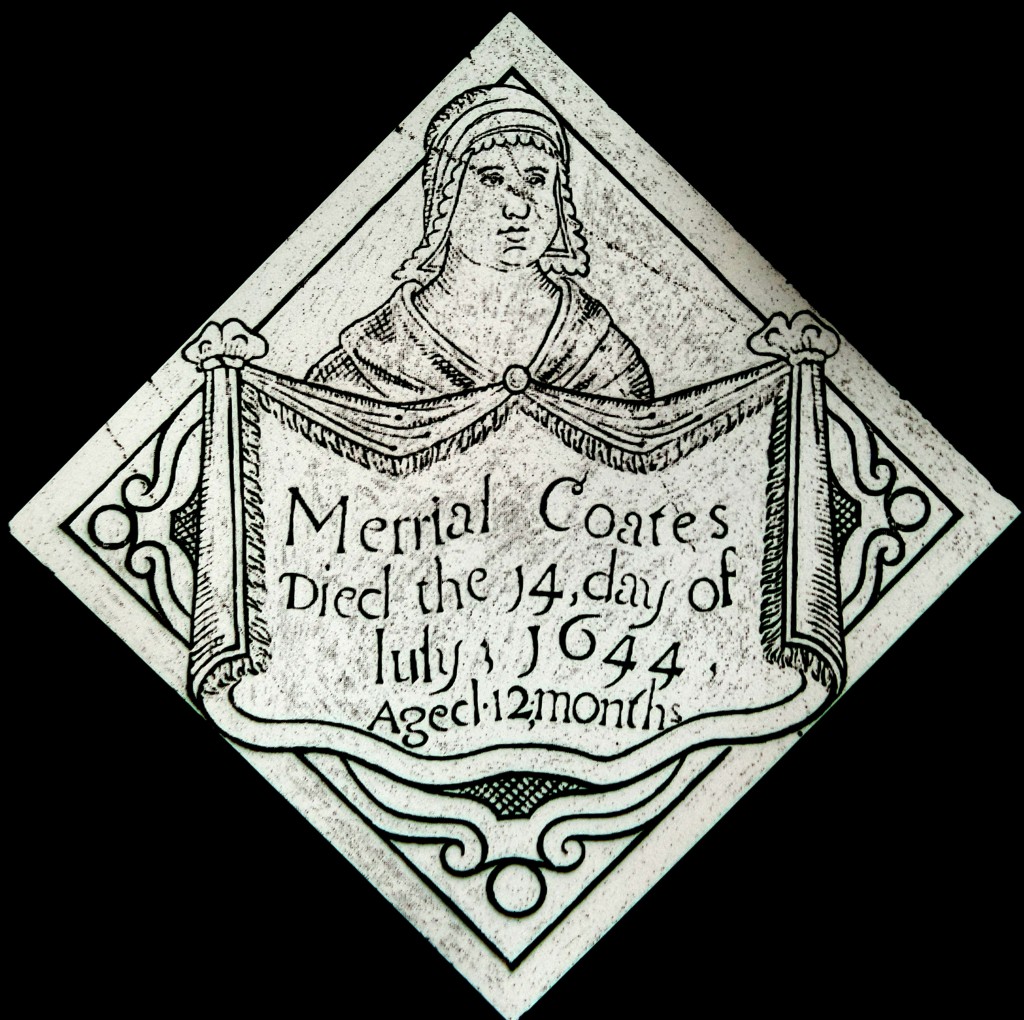
-
John Maunsell
County: Buckinghamshire
Date: 1605/6
May 2024
John Maunsell was born on 22 September 1539, the second son of Richard Maunsell and his wife Margery Fairfax. His will, proved in March 1605/6, a few weeks after his death, shows him to have been a man of considerable means. He left five hundred marks to each of his five younger sons, Tobias, John, Ralph, Thomas and Francis when they reached twenty-four years (or twenty-five in John’s case), and another five hundred marks to his daughter Mary on her marriage. He had previously at the request of his wife given six hundred marks to his daughter Dorothy on her...
read more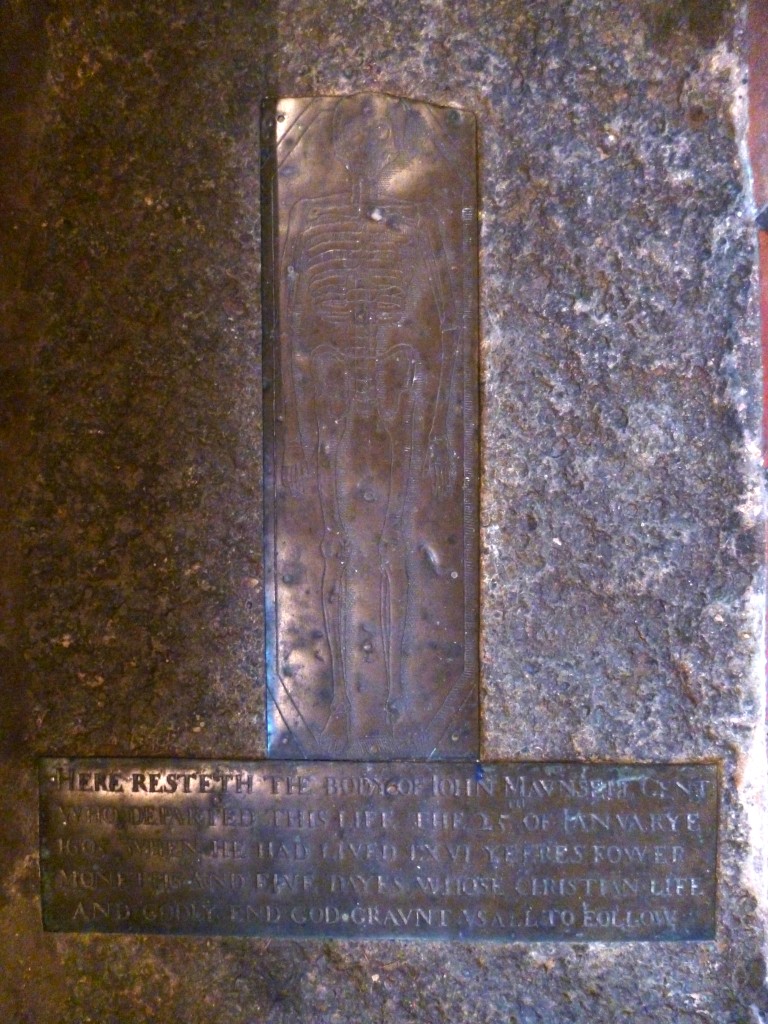
-
Richard de la Pole
County: Suffolk
Date: 1403
April 2024
The collegiate church at Wingfield in Suffolk has indents of a good number of fine former brasses, representing the clerical staff of the college and the family of the founders, but only one still contains any brass. This is a Purbeck marble stone on the floor of the tower, with an the inscription commemorating Richard de la Pole, son of Michael, first earl of Suffolk, and his countess, Katherine Wingfield. Richard’s figure and the shields at the corners of the slab have long since disappeared but their shapes are clear on the slab.
Wingfield College was founded in 1362 under...
read more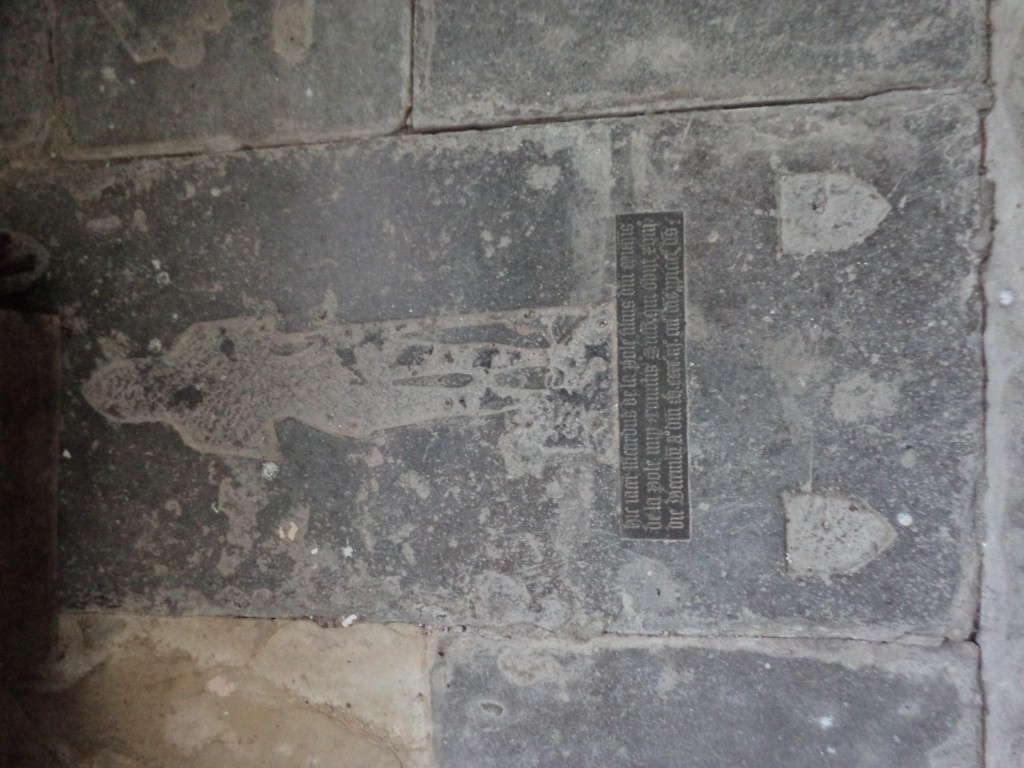
-
Julyen Deryng
County: Kent
Date: 1526/7
March 2024
Not all the brasses of the Dering family in the church of St Nicholas at Pluckley in Kent are quite what they seem. During the seventeenth century Sir Edward Dering, 1st baronet, local landowner and MP, had additional brasses engraved commemorating a number of his ancestors in an antique style. There is some evidence to suggest that their engraver was Edward Marshall.
Sir Edward’s second wife Anne, daughter of Sir John Ashburnham, died on 13 April 1628. After her death, Sir Edward made alterations to Pluckley church and to the Dering chapel within it, laying or relaying ten brasses to...
read more